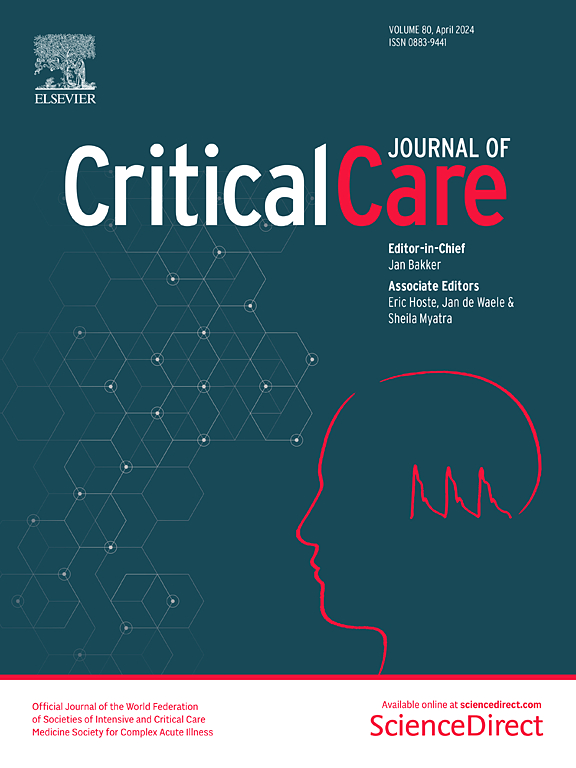Impact of age and mean intracranial pressure on the morphology of intracranial pressure waveform and its association with mortality in traumatic brain injury
IF 8.8
1区 医学
Q1 CRITICAL CARE MEDICINE
引用次数: 0
Abstract
Morphological analysis of intracranial pressure (ICP) pulse waveforms provides indirect information on cerebrospinal compliance, which might be reduced by space-occupying lesions but also by intracranial hypertension and aging. This study investigates the impact of age and mean ICP on the shape and amplitude of ICP pulse waveform in traumatic brain injury (TBI). Additionally, it explores the association between morphological parameters and mortality after TBI. ICP recordings from 183 TBI patients (median age: 50 (30, 61) years) from the CENTER-TBI database were retrospectively analyzed. ICP morphology was assessed using the artificial intelligence-based pulse shape index (PSI) and peak-to-peak amplitude of ICP pulse waveform (AmpICP). The impact of mean ICP, age, and their interaction on PSI and AmpICP were estimated using factorial ANOVA. To account for influence of disturbance in the intracranial volume on AmpICP and PSI, a multiple regression analysis was performed using age, mean ICP, and the Rotterdam CT score as explanatory variables. The associations of AmpICP and PSI with six-month mortality were assessed using the area under the ROC curve (AUC). Age had a predominant influence on PSI (p < 0.01), accounting for 33.1% of its variance, while mean ICP explained 6.6% (p < 0.01). Conversely, mean ICP primarily affected AmpICP (p < 0.01), explaining 22.8% of its variance, with age contributing 8.0% (p < 0.01). A combined effect of age and mean ICP on AmpICP (p = 0.01) explained 11.7% of its variance but did not influence PSI. After accounting for Rotterdam CT score, the results remained consistent, indicating that advanced age has the strongest impact on PSI (β = 0.342, p < 0.01) while elevated mean ICP has dominant influence on AmpICP (β = 0.522, p < 0.01). Both AmpICP and PSI were moderately associated with mortality (AUC: 0.76 and 0.71, respectively). AmpICP and PSI capture distinct aspects of cerebrospinal compliance. PSI appears to reflect age-related stiffening of the cerebrovascular system, while AmpICP, influenced by mean ICP, indicates acute volume compensatory changes. Combined, they provide a more comprehensive assessment of cerebrospinal volume–pressure compensation. Both morphological metrics are associated with mortality after TBI. As cerebrospinal compliance declines with age, older TBI patients become more susceptible to uncontrolled rises in ICP, which can worsen their outcome.年龄和平均颅内压对外伤性脑损伤颅内压波形形态的影响及其与死亡率的关系
颅内压(ICP)脉冲波形的形态学分析提供了脑脊液顺应性的间接信息,脑脊液顺应性可能因占位性病变而降低,也可能因颅内高压和衰老而降低。本研究探讨了年龄和平均颅内压对颅内压脉冲波形形状和振幅的影响。此外,它还探讨了形态学参数与TBI后死亡率之间的关系。回顾性分析来自CENTER-TBI数据库的183例TBI患者(中位年龄:50(30,61)岁)的ICP记录。采用基于人工智能的脉冲形状指数(PSI)和ICP脉冲波形峰间振幅(AmpICP)评估ICP形态。使用因子方差分析估计平均ICP、年龄及其相互作用对PSI和AmpICP的影响。为了解释颅内容积紊乱对AmpICP和PSI的影响,采用年龄、平均ICP和鹿特丹CT评分作为解释变量进行多元回归分析。AmpICP和PSI与六个月死亡率的关系采用ROC曲线下面积(AUC)进行评估。年龄是影响PSI的主要因素(p < 0.01),占方差的33.1%,平均ICP占方差的6.6% (p < 0.01)。相反,平均ICP主要影响AmpICP (p < 0.01),解释22.8%的方差,年龄贡献8.0% (p < 0.01)。年龄和平均ICP对AmpICP的综合影响(p = 0.01)解释了其方差的11.7%,但不影响PSI。考虑Rotterdam CT评分后,结果一致,高龄对PSI的影响最大(β = 0.342, p < 0.01),而平均ICP升高对AmpICP的影响最大(β = 0.522, p < 0.01)。AmpICP和PSI与死亡率均有中度相关性(AUC分别为0.76和0.71)。AmpICP和PSI捕捉脑脊液顺应性的不同方面。PSI似乎反映了与年龄相关的脑血管系统硬化,而AmpICP受平均ICP的影响,表明急性容量代偿变化。综合起来,它们提供了更全面的脑脊液容积压代偿评估。这两种形态学指标都与脑外伤后的死亡率有关。随着年龄的增长,脑脊髓顺应性下降,老年TBI患者更容易出现不受控制的ICP升高,这可能使其预后恶化。
本文章由计算机程序翻译,如有差异,请以英文原文为准。
求助全文
约1分钟内获得全文
求助全文
来源期刊

Critical Care
医学-危重病医学
CiteScore
20.60
自引率
3.30%
发文量
348
审稿时长
1.5 months
期刊介绍:
Critical Care is an esteemed international medical journal that undergoes a rigorous peer-review process to maintain its high quality standards. Its primary objective is to enhance the healthcare services offered to critically ill patients. To achieve this, the journal focuses on gathering, exchanging, disseminating, and endorsing evidence-based information that is highly relevant to intensivists. By doing so, Critical Care seeks to provide a thorough and inclusive examination of the intensive care field.
 求助内容:
求助内容: 应助结果提醒方式:
应助结果提醒方式:


